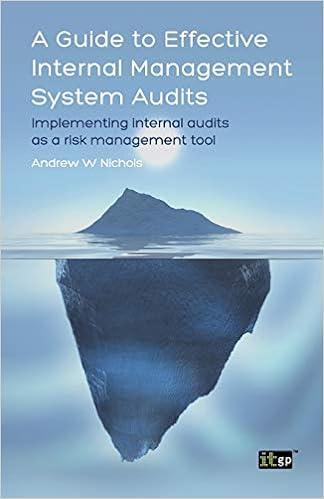Answered step by step
Verified Expert Solution
Question
1 Approved Answer
Audit Procedures for Financial Institutions: Auditing financial institutions involves specialized procedures tailored to the unique risks and complexities inherent in the industry. These institutions, including
Audit Procedures for Financial Institutions:
Auditing financial institutions involves specialized procedures tailored to the unique risks and complexities inherent in the industry. These institutions, including banks, credit unions, and investment firms, play a crucial role in the economy and are subject to stringent regulatory requirements. Audit procedures for financial institutions aim to provide assurance on the accuracy, reliability, and compliance of financial statements and internal controls. Here are some key audit procedures commonly performed:
Risk Assessment: Auditors conduct a thorough risk assessment to identify and understand the specific risks faced by the financial institution. This includes risks related to credit, liquidity, market, operational, and regulatory compliance. Understanding these risks allows auditors to tailor their audit procedures to address areas of higher risk.
Internal Control Evaluation: Auditors evaluate the effectiveness of internal controls established by the financial institution to mitigate identified risks. This involves testing the design and operating effectiveness of key controls related to financial reporting, compliance, and safeguarding of assets. Common internal controls include segregation of duties, authorization procedures, and reconciliation processes.
Loan Portfolio Review: Auditors review the institution's loan portfolio to assess the quality and collectability of loans. This includes evaluating the adequacy of loan loss reserves, assessing the valuation of collateral, and testing the accuracy of loan classifications. The loan portfolio is a significant asset for financial institutions, and its proper valuation is critical for assessing the institution's financial health.
Investment Portfolio Examination: Auditors examine the institution's investment portfolio to evaluate its composition, valuation, and compliance with regulatory requirements. This includes reviewing investment policies, assessing the fair value of investments, and verifying compliance with investment guidelines and restrictions.
Regulatory Compliance Testing: Auditors perform testing to ensure the financial institution's compliance with applicable regulatory requirements. This involves reviewing regulatory filings, assessing adherence to capital adequacy ratios, evaluating antimoney laundering controls, and verifying compliance with consumer protection laws such as the Truth in Lending Act and the Bank Secrecy Act.
Fraud Detection Procedures: Auditors implement procedures to detect and prevent fraud within the financial institution. This includes assessing the risk of fraud, performing analytical procedures to identify unusual transactions, and conducting interviews with management and staff to gather information on potential fraud risks.
Question:
In audit procedures for financial institutions, what is the primary purpose of evaluating internal controls?
A To assess the quality of the loan portfolio
B To detect and prevent fraud
C To evaluate compliance with regulatory requirements
D To mitigate identified risks and ensure the reliability of financial reporting

Step by Step Solution
There are 3 Steps involved in it
Step: 1

Get Instant Access to Expert-Tailored Solutions
See step-by-step solutions with expert insights and AI powered tools for academic success
Step: 2

Step: 3

Ace Your Homework with AI
Get the answers you need in no time with our AI-driven, step-by-step assistance
Get Started


